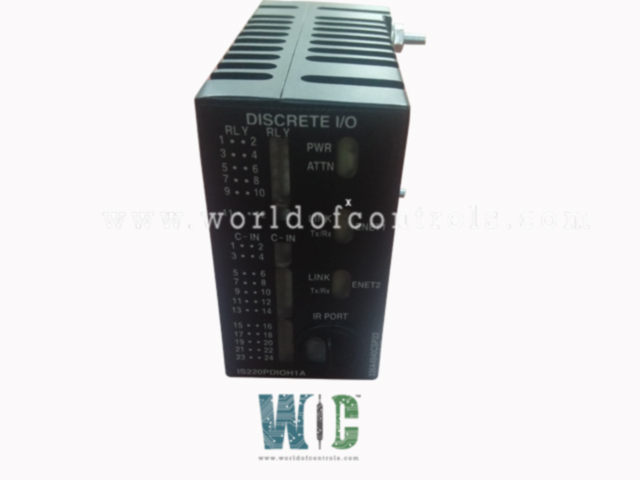
World Of Controls understands the criticality of your requirement and works towards reducing the lead time as much as possible.
IS220PDIOH1A, REV D - Discrete Input/Output Module is available in stock which ships the same day.
IS220PDIOH1A, REV D - Discrete Input/Output Module comes in UNUSED as well as REBUILT condition.
To avail our best deals for IS220PDIOH1A, REV D - Discrete Input/Output Module, contact us and we will get back to you within 24 hours.
SPECIFICATIONS:
Part Number: IS220PDIOH1A, REV D
Manufacturer: General Electric
Series: Mark VIe
Input isolation in pack: Optical isolation to 1500 V
Input Filter: Hardware filter, 4 ms
Ac voltage rejection: 60 V rms
Number of relay command channels: 12
Number of input channels: 24 DI and 12 form C
Operating Temperature: 0 to 60°C
Product Type: Discrete Input/Output Module
Size: 15.875 cm high x 10.795 cm wide
Country of Origin: United States
Availability: In Stock
Manual: GEH-6721G
FUNCTIONAL DESCRIPTION:
IS220PDIOH1A, REV D is a Discrete Input/Output Module manufactured and designed by General Electric as part of the Mark VIe Series used in distributed control systems. The Discrete Input/Output (PDIO) pack serves as the electrical interface between one or two I/O Ethernet networks and a discrete input/output terminal board. It consists of a processor board, shared across all Mark* VIe distributed I/O packs, and an acquisition board dedicated to discrete input/output functions. The pack can accept up to 24 contact inputs, control 12 relay outputs, and receive terminal board-specific feedback signals. The terminal board determines the voltage capability of the PDIO. System input is provided via dual RJ45 Ethernet connectors and three-pin power input, while discrete signal input/output is handled through a DC-62 connector linked to the terminal board. Visual diagnostics are available via indicator LEDs, and local diagnostics can be accessed through an infrared port.
The PDIO functions as the combined equivalent of a PDIA and PDOA I/O pack in a single assembly. For simplex applications, it is mounted on a TDBS terminal board, which combines the features of an SRLY relay terminal board and an STCI contact input terminal board. For TMR applications, it is mounted on a TDBT terminal board, and when equipped with the WROB option, it provides the combined functionality of a TRLYH1B relay terminal board and a TBCI contact input terminal board.
COMPATIBILITY:
PDIOH1A is compatible with two types of discrete contact input/output terminal boards: TDBS for single PDIO applications and TDBT for TMR PDIO applications. The relay output portion of the terminal board accepts option cards as described later in this document. The following table gives details of the compatibility:
INSTALLATION:
OPERATION:
CONTACT INPUT SIGNALS:
The discrete input/output acquisition board performs the second stage of signal conditioning and level shifting to interface terminal board inputs with the control logic. The initial signal conditioning is handled by the terminal board. The input circuit features a comparator with a variable threshold, and each input is isolated from the control logic by an optocoupler and a separate power supply, though the inputs are not isolated from each other. Each of the 24 inputs includes filtering, hysteresis, and a yellow status LED that lights up when an input is active. The LED is off when the input is inactive. These LEDs are located at the bottom left of the PDIO pack.
WOC has the largest stock of OEM Replacement Parts for GE Distributed Control Systems. We can also repair your faulty boards and supply unused and rebuilt boards backed up with a warranty. Our team of experts is available round the clock to support your OEM needs. Our team of experts at WOC is happy to assist you with any of your automation requirements. For pricing and availability on parts and repairs, kindly contact our team by phone or email.
How do I connect the PDIO I/O pack to the system?
For simplex applications, insert one PDIO I/O pack into the terminal board connectors. For TMR applications, use three PDIO I/O packs. Secure the packs using the threaded studs and connect the Ethernet cables and power supply as needed.
What type of communication does the PDIO I/O pack support?
The PDIO I/O pack supports Ethernet communication with dual 10/100 Ethernet ports and also includes an infrared serial communication port for diagnostics.
How does the status indication work on the PDIO I/O pack?
Each of the 24 inputs features a yellow status LED that lights up when an input is active and turns off when the input is inactive. The LEDs are grouped at the bottom left of the PDIO pack for easy monitoring.